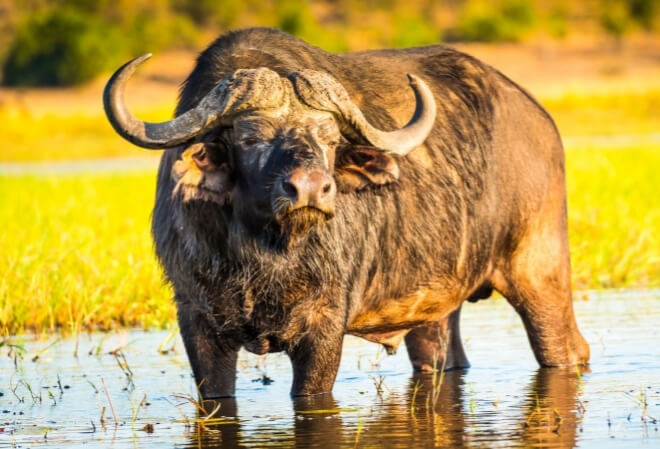Introduction
While hunting buffalo in South Africa is not for everyone, it is an amazing experience. Not only do you get the thrill of the hunt, but also the satisfaction of having put meat on your table from an animal that you hunted. If you are up for the challenge, then read on and learn some tips and strategies that will help make your next buffalo hunt a success!
Cape Buffalo
The Cape buffalo is a large African bovine species. It is a very aggressive and unpredictable animal that can weigh up to 1,200 pounds and can be dangerous to hunt with a bow. They are also very dangerous to hunt with a rifle because they are hard for even the most skilled hunters to kill with this weapon type.

Buffalo Shot Placement
Shot placement is important, but it depends on the distance to the buffalo. If you’re shooting at close range (under 100 yards), aim for the heart/lung area and avoid hitting heavy bones such as those in a buffalo’s spine. It’s easier to hit a deer than it is a buffalo because of the size difference between these animals. The secret to hunting buffalo is staying calm when you make your shot and follow through with your technique, even if things don’t go as planned.
The Potbelly Shot (Quartering Away)
The potbelly shot, also known as the quartering away shot, is ideal when you are facing your buffalo head-on (they’re coming straight at you). You want to aim for the small of the back, which is just behind the shoulder blade. This will allow for penetration through both shoulders and into their vitals. If they are moving away from you or directly behind you, it’s best not to shoot at all but rather wait until they turn around and face in another direction.
If there is a group of buffalo close together and they’re all traveling in one direction with some distance between each other, it’s best if they are facing slightly away from your position so that when fired upon one will drop immediately while others may not be able to hear or see what happened right away because of distance traveled before noticing anything out of place.
The Angled Chest Shot (Buffalo Broadside)
- Identify the target.
- Identify the angle of the shot.
- Determine distance and wind conditions.
- Observe for sun and shadows, as well as brush or trees in front of you that may interfere with your shot.
- Look at terrain features such as boulders, hillsides, etc., which can help you judge the range to your target or give you a better idea of where your bullet will land if it’s deflected by structures or obstacles (which happens more often than you might think). You can also use these features to prevent yourself from being seen by other animals or people who might be nearby (if you’re hunting with a group). If this isn’t possible because there are no terrain features nearby then just try finding cover behind some tall grasses; this way when someone does come along then all they’ll see is their own reflection instead of YOU! 🙂
The Angled Chest Shot (Quartering Away)
The angle of the shot is important when hunting buffalo. If you’re hunting at a distance of 50 yards or less, your shot placement should be straight to the shoulder or slightly behind it. You’ll have a much better chance of hitting the target if you shoot at an upward angle instead of aiming right at its chest.
If you’re hunting a buffalo that’s farther away (more than 50 yards), then shoot either directly ahead into its chest or slightly behind this area of its body—about 1/3 down its back toward its tail end.
The Front Shoulder Shot (Broadside)
The front shoulder shot is one of the most common and effective shots that you can take on a buffalo. It is taken when they are broadside to you or facing your direction at an angle of 90 degrees or less. You should always try to get behind them if possible, as this gives you a better chance of scoring a clean shoulder hit.
When hunting buffalo using the front shoulder shot, distance is important! If you are too far away from your target and miss your first shot, then it will be difficult for you to get another opportunity before it becomes dangerous for you (and/or others). At close range (<15m) it is easy for them to charge after being hit in this area so make sure that they are coming towards you at an angle where they cannot hit any bystanders or members of your party!
Underneath the Chin and Behind the Eye Shot
When hunting in South Africa, you will most likely be hunting from an elevated position on a hill or a tree stand. This allows you to have an unobstructed view of your target and avoid any obstacles that could cause your shot to miss the animal or worse yet, hit the wrong one. The best shots will be taken when the buffalo is standing broadside to you with its head down grazing on grass or leaves. It is important that you aim between the front legs at the base of their neck just behind and below their chin so that if they do charge they will run onto your bullet instead of over it as there are vital organs and arteries running through this area which could kill them instantly if it was hit by another shot or even by falling off a cliff! This area must also be considered when attempting this shot as well if your first attempt doesn’t work out like planned because animals can change direction very quickly once they have made up their mind about something so having extra space around them gives hunters more time for error before becoming prey themselves!
If all else fails try again later but remember keeping calm during these situations helps too!”
Hunting buffalo in South Africa with a bow can be very dangerous, but very rewarding if you are successful.
Hunting buffalo with a bow can be very dangerous, but very rewarding if you are successful. Before you get started, make sure that you have all the gear and supplies needed to be successful and survive. You need to have a good pair of boots, warm clothing, good food, and water (if possible), as well as some basic first aid items. If there is anyone in your group who does not own these things already then make sure they do before departing on your hunt.
In addition to those things listed above; it is also important that everyone involved understands the dangers associated with hunting buffalo by bow because it can be one of the most challenging hunts out there for this type of weapon. For example: A wounded animal will not just lie down like an animal shot with a rifle would; instead they will run away after being hit by an arrow making them harder targets when looking through scopes or binoculars while tracking during hunts which could lead up to bad outcomes depending upon how far away these animals get before someone finds them again which could take hours or even days depending upon how many people are involved in such pursuits.”
Conclusion
I hope this blog post has given you some insight into the hunting of Cape Buffalo in South Africa. It is by no means an easy animal to hunt and requires a lot of practice before going out into the field with your bow. If you do want to do this, then I would suggest getting as much experience as possible on other plains game animals before setting foot in Africa. If you are serious about doing this type of hunt then make sure that you get advice from someone who has done it before!




